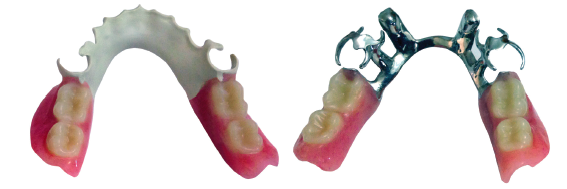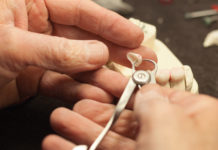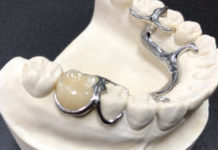A Discussion with the Team at Solvay Dental 360™ and LaMont Carpenter at Arrowhead Dental Laboratory about Ultaire™ AKP.
Aesthetic Dentistry recently spoke with Albert Garza, Head of Customer Engagement, and Michael Larsson, Business Development Manager, West Region, from Solvay Dental 360, and LaMont Carpenter, Arrowhead’s Technical Consultant, to learn about a unique new material, and how it is transforming the options for patients interested in Removable Partial Dentures (RPDs). Here’s a brief synopsis of that conversation:
AD: WHAT TYPES OF REMOVABLE PARTIAL DENTURE (RPD) OPTIONS ARE CURRENTLY AVAILABLE FROM ARROWHEAD DENTAL LABORATORY?
LC: For several years Arrowhead Dental Lab has offered two types of removable partial dentures—cast metal, and acrylic. Recently, Arrowhead has started offering the Ultaire™ AKP RPD. We’ve been making RPDs with Ultaire™ for a few months now, and they’re really increasing in popularity.
Arrowhead is excited to offer RPDs with Ultaire™ AKP because they provide several innovative advantages for patients and clinicians. If a clinician has any questions about RPDs, he or she can call Arrowhead or their dental laboratory to discuss the different options available for the particular needs of their patient.
AD: HOW MANY PATIENTS ARE PRESCRIBED RPDs EACH YEAR?
Solvay: According to our research, about 2 million patients are prescribed RPDs annually. Before Ultaire™AKP, the most popular option was a metal appliance. Metal RPDs don’t offer a comfortable fit for the patient, and they typically require five to seven fitting sessions, which obviously takes up a lot of chair time and is an inconvenience for clinicians and patients alike. Being able to eliminate multiple fitting sessions frees up chair time for clinicians and can increase patient compliance, which can be a significant issue with metal RPDs.
For patients, RPDs with Ultaire™ are significantly more lightweight than chrome cobalt frames, and they don’t have any kind of metallic taste, or the uncomfortable thermo transfers of heat and cold in the patient’s mouth.

![]()
AD: WHAT IS ULTAIRE™ AKP?
Solvay: Ultaire™ AKP is a material made specifically for RPDs. The AKP stands for aryl ketone polymer. It’s a class two, nonsterile medical device material. It can also be used for overdentures and implant-supported overdentures. We’re really happy to offer it to dental labs and dentists.

![]()
AD: CAN YOU TELL US A LITTLE BIT ABOUT SOLVAY AND ITS BACKGROUND?
Solvay: Solvay was founded in 1853 in Belgium, and its mission is to encourage and support scientific advancement for solutions to the problems of everyday life. In 1911, founder Ernest Solvay created the first ever physics council, where he brought together some of the luminaries of the time—including Albert Einstein and Marie Curie. Today, the physics council still meets every three years in support of the same mission.
Throughout its history, Solvay has created raw materials that are integrated into a lot of dental tools that clinicians use on a daily basis. Solvay offers an unrivaled portfolio of highperformance polymers, consisting of more than 35 brands and 1,500 formulations. Currently, Solvay supplies implantable and non implantable polymers to the orthopedic, cardiovascular, and renal markets.
Solvay Dental 360™ is backed by Solvay, a world leader in metal-replacing materials in healthcare and many other industries. We bring more than 150 years of expertise and innovation to the dental industry which resulted in Ultaire™ AKP.
AD: WHY DID SOLVAY DECIDE TO ENTER THE DENTAL MARKET?
Solvay: Before Solvay Dental 360™ entered the dental industry, removable partial dentures (RPDs) hadn’t seen significant innovation in well over 150 years. Chrome cobalt was typically the standard of care for RPDs, starting with the first metal frame in 1728.
Until recently, removable partial dentures were some of the only restorations in the dentistry industry that were still overwhelmingly fabricated using metal. Solvay saw a need in this market and was uniquely qualified to fill it. With many Ph.D. scientists focused on our specialty polymers group, we developed a product to serve a huge patient population that deserved something better.
AD: WHAT ARE THE ADVANTAGES OF USING RPDs WITH ULTAIRE™ VERSUS TRADITIONAL MATERIALS?
Solvay: Ultaire™ AKP RPDs are metal-free, comfortable, tooth-supported, bone-like, lightweight, biocompatible, and more aesthetically pleasing than traditional metal frames. All these benefits add up to increased patient compliance.

With chrome cobalt appliances, a lot of patients would only wear their RPDs when they needed to—when they were leaving the house to go out in public, or for family photos and the like. Metal RPDs can be uncomfortable and have visible, shiny clasps. Because patients aren’t very compliant with consistent wear, they often get mesial drift, and teeth can move in different directions—which is very difficult for clinicians to correct.
In addition, a lot of patients with chrome cobalt RPDs have issues with tissue sensitivity and having a fulcrum or a point constantly under duress during mastication. With Ultaire™ AKP, lab technicians can create a more passive fit and get better retention because the material has a little bit of flex to it.
The flex helps patients keep the prosthesis secure and in place.
It’s worth noting, however, that Ultaire™ AKP is not a flexible appliance; it’s a high-performance polymer. It’s rigid, yet comfortable. And it offers a secure fit. While acrylic frames can be attractive aesthetically, they tend to float around because they don’t have built-in retention.
In contrast, Ultaire™ AKP RPDs are rigid enough to be tooth-supported, and the clasps are designed to engage undercuts more deeply, providing better retention. This, along with the fact that Ultaire™ AKP RPDs are lightweight and comfortable, can help increase patient compliance and make them something that patients will want to wear regularly.
LC: Sometimes flexible partial dentures with acrylic are almost too flexible. They don’t rest on teeth, but instead rest on tissue. Therefore, every time a patient bites down, it moves and can push the tissue down. Ultaire™ is less flexible and is toothsupported, which is nice because it doesn’t damage the tissue.
Another advantage of Ultaire™ is that it is reline-able. Relining is when, after years of wear, the gum tissue starts to shrink and the fit of the RPD is somewhat compromised. When that happens on an Ultaire™ AKP RPD, the dental laboratory technicians may be able to go back in and fill in the space between the tissue and the RPD.
As noted earlier, another benefit with Ultaire™ is how lightweight the appliance is. Patients almost don’t feel the RPD when they are wearing it because it is so comfortable.
In addition, Ultaire™ clasps are white, so people don’t see the silver clasps around the teeth like they do with metal RPDs. Ultaire™ clasps “grab” the back of the tooth and stay there—it’s an improved clasp design. Furthermore, the clasps don’t bend or move if the RPD is accidently dropped.
AD: WHO IS THE IDEAL PATIENT FOR AN ULTAIRE™ RPD, AND WHAT CHARACTERISTICS SHOULD CLINICIANS LOOK FOR?
LC: Ultaire™ RPDs are particularly suited for the following patients: someone who uses a metal RPD and complains or asks for options that don’t involve a metal taste in the mouth, someone who thinks their RPD feels thick or bulky, someone who doesn’t want to have metal clasps showing in their mouth, someone who is allergic to metal, and someone who wants a more lightweight, more comfortable RPD.

AD: CAN PATIENTS WITH ALLERGIES TO CERTAIN MATERIALS USE THIS PRODUCT?
Solvay: Ultaire™ AKP is not made from metal, but rather a high-performance polymer similar to those used in spine and hip implants. This biocompatible material is monomer free, and has a reduced occurrence of sensitivity issues, making Ultaire™ AKP an excellent choice for patients with metal sensitivities.
LC: The fact that Ultaire™ is a metal-free material is great for dental practices that are metal-free (meaning they are not using any metals as restoratives in the mouth). More and more patients are asking for alternatives to metal restoratives, and we’re happy to offer a new option for them.
AD: HOW STRONG IS ULTAIRE™ AKP?
Solvay: Strength characteristics for Ultaire™ AKP surpass those of both acrylics and acetals that are on the market today. The flexural strength of any material used for RPDs needs to be high enough to withstand loading and not break.
At 148 MPa, Ultaire™ AKP has flexural properties that are well above the minimum requirements for denture base materials per ISO 20795 standards. Ultaire™ AKP is specifically designed to be supportive and have a long lifetime—well over 10 years with normal insertion and removal—but also to be comfortable enough to help improve patient compliance.
AD: WHAT SHADES OF THE MATERIAL ARE CURRENTLY AVAILABLE?
Solvay: At this time, only one color (white) is available. We are continually developing new options based on user feedback and plan on introducing additional shades, including pink, in the near future.
AD: CAN ULTAIRE™ AKP RPDs BE MODIFIED?
Solvay: Adjustments or tightening should not be necessary with an RPD made from Ultaire™ AKP after it has been designed and milled. To slightly relieve the fit, technicians may carefully remove material from the clasps of an Ultaire™ AKP using existing dental tools if necessary. It is recommended that minor alterations stay within design guidelines. Because Ultaire™ AKP is a high performance polymer, the shape of the RPD may not be changed.
AD: CAN TEETH BE ADDED TO AN ULTAIRE™ AKP RPD?
Solvay: Teeth may be added under specific circumstances. To learn more about the possibilities, speak with a representative from Arrowhead or your dental laboratory for details and specifications.
AD: SHOULD DOCTORS USE CONVENTIONAL IMPRESSIONS WHEN REQUESTING AN RPD WITH ULTAIRE™?
Solvay: Ideally, we recommend that clinicians utilize a custom impression tray with border molding and a quality impression material. This provides more options when processing the acrylic, but as noted, digital impressions work just fine, too.
LC: Doctors can use conventional or digital impressions, whatever is easier for them. Either way, the impressions will be digitally scanned so we can work with them.
AD: WHAT IS THE TYPICAL LIFESPAN OF AN RPD WITH ULTAIRE™ AKP?
Solvay: Bench testing has shown that Ultaire™ AKP should maintain its original shape for up to 10 years.
AD: WHAT IS THE RECOMMENDED MAINTENANCE FOR AN RPD WITH ULTAIRE™ AKP?
LC: Like any denture or removable partial denture, patients should remove Ultaire™ AKP RPDs at night and conscientiously clean them. Calculus will build up on any of these appliances pretty quickly if patients don’t take care of them. If patients are diligent with a home care cleaning routine, including daily brushing, soaking the RPDs in a denture solution overnight, and handling the appliances properly, they will last a long time.









